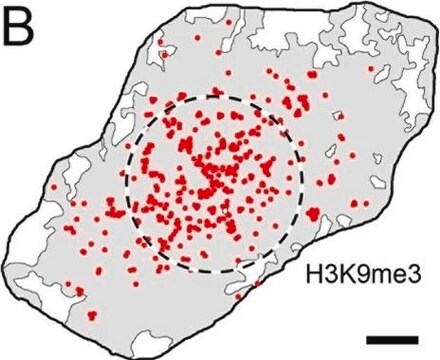04-928
Anti-Histone H3 Antibody, CT, pan, clone A3S, rabbit monoclonal
culture supernatant, clone A3S, Upstate®
Synonym(s):
H3, Histone H3
About This Item
Recommended Products
biological source
rabbit
Quality Level
antibody form
culture supernatant
antibody product type
primary antibodies
clone
A3S, monoclonal
species reactivity
human, rat, Saccharomyces cerevisiae, mouse, chicken
manufacturer/tradename
Upstate®
technique(s)
ChIP: suitable
western blot: suitable
isotype
IgG
NCBI accession no.
UniProt accession no.
shipped in
dry ice
target post-translational modification
unmodified
Gene Information
human ... H3F3B(3021)
General description
Specificity
Immunogen
Application
Epigenetics & Nuclear Function
Histones
Chromatin Immunoprecipitation:
2 μL of of a previous lot of this antibody immunoprecipitated chromatin associated with Histone H3 from a wild type yeast lysate.
Quality
Target description
Linkage
Physical form
Storage and Stability
Handling Recommendations: Upon receipt, and prior to removing the cap, centrifuge the vial and gently mix the solution. Aliquot into microcentrifuge tubes and store at -20°C. Avoid repeated freeze/thaw cycles, which may damage IgG and affect product performance.
Legal Information
Disclaimer
Not finding the right product?
Try our Product Selector Tool.
Storage Class Code
12 - Non Combustible Liquids
WGK
WGK 1
Flash Point(F)
Not applicable
Flash Point(C)
Not applicable
Certificates of Analysis (COA)
Search for Certificates of Analysis (COA) by entering the products Lot/Batch Number. Lot and Batch Numbers can be found on a product’s label following the words ‘Lot’ or ‘Batch’.
Already Own This Product?
Find documentation for the products that you have recently purchased in the Document Library.
Our team of scientists has experience in all areas of research including Life Science, Material Science, Chemical Synthesis, Chromatography, Analytical and many others.
Contact Technical Service






